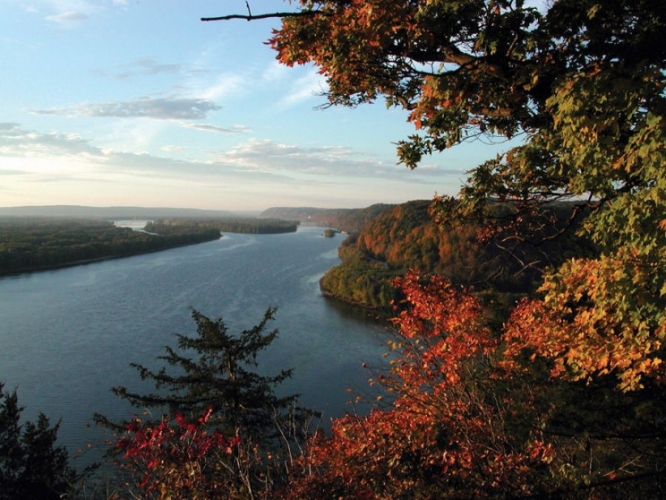
Source: NPS/Wikimedia Commons
Watersheds and river basins: Here's why they are vitally important
Mar 26, 2022 at 8:35am
Earth is unique in the Solar System for being the only planet with liquid water on its surface. And this water is not isolated to just little pockets here and there - it is literally everywhere in some form on Earth's surface.
What's more, this water doesn't just sit around doing nothing - it is constantly moving and changing state. This cycle, called the water cycle, involves the continuous movement of water between the Earth's oceans, atmosphere, and land.
Even on land, water is constantly moving and cycling. Some of this involves watersheds, areas of land that contain streams and rivers, which all drain into the same larger body of water, such as a large river, lake, or ocean.
But what exactly are watersheds and how do they work? Let's find out.
What is a watershed?
Watersheds are areas of land that feed major water bodies like streams, rivers, lakes, and, of course, the ocean. In fact, all lands on Earth are part of one watershed system or another. Each part of a watershed, in essence, feeds water, to a greater or lesser extent, into some common point or points.
By way of example, take the mighty Mississippi River. The Mississippi flows some 2,350 miles from its source at Lake Itasca through the center of the continental United States to the Gulf of Mexico. This river is fed by an enormous watershed that contains all the smaller tributaries that drain water into the river. Altogether, the Mississippi River drainage basin (which is often said to include the Missouri and Ohio Rivers) is the fourth largest drainage basin in the world.
All bodies of water have to be replenished in some form or another or they will, over time, simply dry up. This is why watersheds, otherwise known as catchment areas, are so important for many aspects of life on this planet.
Moreover, watersheds come in many shapes and sizes and are not isolated entities in their own right. A drainage basin is the area of land drained by a river. A watershed is the area surrounding a drainage basin and often marks the boundary between two drainage basins. A drainage basin may in fact consist of a large number of watersheds, which together form a large and complex web.
Minnesota, for example, contains eight major drainage basins and 81 major watersheds. Some of these extend into other states or countries (Canada). From this, you can see that proper watershed management not only affects local communities, but can have wide-ranging implications for residents of other areas, and even other nations.
What are the 5 major types of watersheds?
Watersheds can be classified depending on their relative size, drainage, shape, soil type, climate, and land use pattern.
In terms of size, watersheds tend to fall into one of the following main types:
1. A macro watershed - these are the largest of all and tend to have an area in excess of 50,000 hectares or 500 km2.
2. Sub-watersheds - these are the next largest and tend to fall between 10,000 and 50,000 hectares, or between 100 and 500 km2.
3. Milli-watersheds - these are watersheds with areas between 1,000 hectares (10km2) and 10,000 (100km2) hectares.
4. Micro watersheds- These are the second smallest kind and tend to have an area between 100 (1 km2) and 1000 hectares (10 km2).
5. Mini watersheds - These are the smallest kind and tend to be those with areas less than 100 hectares (1 km2).
What are the main components of watershed management?
As you can appreciate, watersheds are vitally important for all life on land. For this reason, proper management of them is incredibly important for both nature and human civilization.
To this end, most nations will operate some form of watershed management program, but the level of sophistication and regulation can vary widely. However, in most cases, watershed management will encompass some or all of the following:-
Good watershed management will attempt to control runoff and degradation to conserve soil and water as far as reasonably practicable. This is in part to protect natural habitats, but also to maximize the production of human activities on the land, like farming.
It will also attempt to manage and utilize any runoff water for useful purposes such as irrigation or, indeed, drought prevention.
They will attempt to protect, conserve, and improve watershed land to maximize efficiency and sustainable production.
The system will also try to protect and enhance the water resources that come from the watershed.
Soil erosion will be constantly monitored, with attempts made to reduce the effect of sediment yield on the watershed.
Any deteriorating lands will be rehabilitated at the earliest opportunity.
It will have some policy for moderating the peak flood flows at downstream areas.
Strategies will be found and developed to increase the infiltration of rainwater.
It will attempt to improve and increase the production of timbers, fodder, and wildlife resource.
It will also attempt to enhance the groundwater recharge, wherever applicable.
Continue reading the article from Interesting Engineering here.
